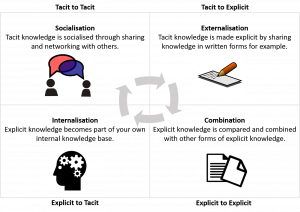How groups create knowledge
Nonaka and Takeuchi (1995) developed the knowledge creation cycle to distinguish between tacit and explicit knowledge.
Tacit knowledge:
The knowledge you have but cannot express, and you may not even know you have it. It is often procedural; focussing upon how things get done.
Have you ever tried to explain, giving directions and found that although you are familiar with the route, you cannot explain how to get there? That is because much of your know-how has developed almost automatically and non-verbally, it is ‘tacit’.
Explicit knowledge:
The knowledge you can easily share, and you can write it down or tell people about it.
The following diagram shows how tacit and explicit knowledge evolves. The inner arrow circle describes the processes you might engage in as knowledge evolves.
 Creating knowledge and problem-solving in groups involves:
Creating knowledge and problem-solving in groups involves:
- questioning
- showing
- challenging
- testing ideas and practices
- teasing out our tacit knowledge and that of others to build new understandings.
Nonaka and Takeuchi (1995) suggest that you can stimulate knowledge creation by:
- Challenging your own tacit assumptions
- Working with peers to create tacit knowledge
- Constantly inquiring and attempting to render tacit knowledge explicit
- Exchanging explicit knowledge
- and internalising explicit knowledge
Adapted from: Nonaka, I., & Takeuchi, H. (1995). The knowledge-creating company: How Japanese companies create the dynamics of innovation. Oxford university press
Pause to reflect
- When did you last make your tacit knowledge explicit?
- Was it understood by the other party?
- If so, how did you achieve this?
- If not, what could you do better next time to develop the other party’s understanding?

